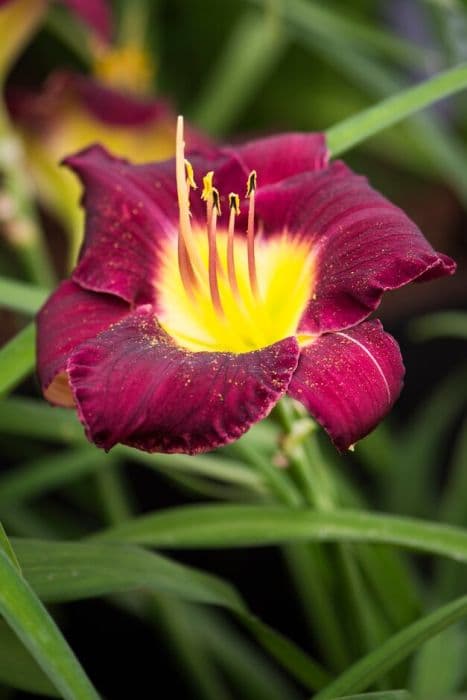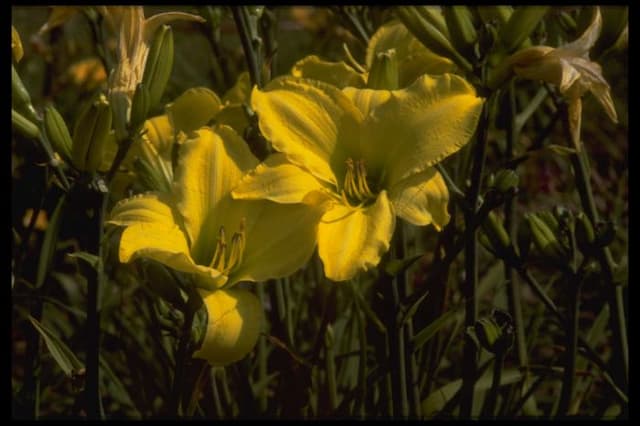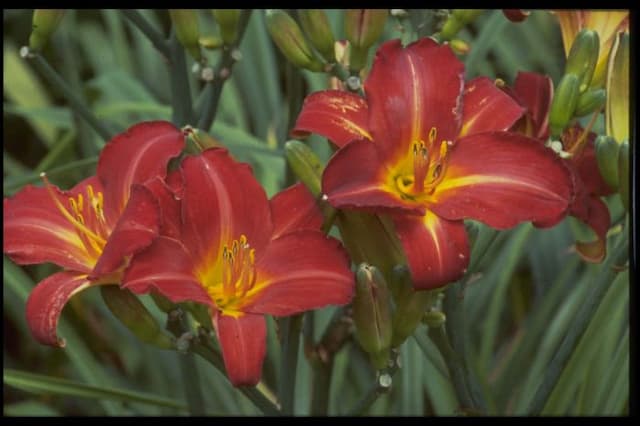Daylily Hemerocallis 'Cathy's Sunset'

ABOUT
Hemerocallis 'Cathy's Sunset', commonly known as the daylily, is a striking perennial plant that is prized for its vibrant blooms. Its flowers are the standout feature, with petals that exhibit a gradation of warm colors reminiscent of a sunset. Typically, these blossoms display a blend of oranges, reds, and yellows, forming a captivating color palette that draws the eye. The individual flowers of the daylily are trumpet-shaped, opening up from a narrow base into a wide, flaring display. Each petal often has slightly ruffled edges, adding a touch of elegance and texture to the bloom. The center of the flower, known as the throat, may contrast with the petals, often showing a deeper or lighter tone that enhances the sunset effect. Daylily foliage is also noteworthy, consisting of long, slender, arching leaves that form a dense clump. The leaves are a deep green color, creating a lush backdrop for the brightly colored flowers. The leaves emerge from the base of the plant, and their fountain-like arrangement adds to the overall aesthetically pleasing structure of the daylily. Flowers are borne on long, smooth stems that rise gracefully above the foliage. These stems are strong and upright, each carrying multiple buds that open successively over time. This ensures a long blooming period, providing a continuous display of color in the garden. 'Cathy's Sunset' blooms in the warmer months, and each flower typically lasts for just one day before being replaced by another, hence the name "daylily." Despite the fleeting nature of individual blooms, the plant as a whole provides a long-lasting and dynamic visual impact in any landscape. The daylily is a favorite among gardeners not only for its beauty but also for its hardiness and ability to thrive in a variety of conditions.
About this plant
 Names
NamesSynonyms
Daylily, Common Daylily, Tawny Daylily, Orange Daylily.
Common names
Hemerocallis 'Cathy's Sunset'.
 Toxicity
ToxicityTo humans
Daylilies, including Hemerocallis 'Cathy's Sunset', are generally not considered toxic to humans. In fact, some parts of certain daylily species are edible and consumed in various culinary dishes, especially in Asian cuisines. However, individuals with sensitive stomachs or those who are allergic to daylilies might experience mild digestive upset if the plant is ingested. It is always advisable to exercise caution and ensure proper identification before consuming any plant material.
To pets
Daylilies are toxic to cats. Ingesting even a small amount of any part of the plant can cause serious kidney damage in cats, leading to symptoms such as vomiting, lethargy, and reduced appetite. If not treated promptly, ingestion can lead to kidney failure or death. Dogs may experience mild gastrointestinal upset if they consume daylilies, but it is not considered to be as life-threatening as it is for cats. Pet owners should prevent their pets, especially cats, from having access to daylilies.
 Characteristics
CharacteristicsLife cycle
Perennials
Foliage type
Deciduous
Color of leaves
Green
Flower color
Mixed
Height
2 feet 24 inches (61 cm)
Spread
2 feet 24 inches (61 cm)
Plant type
Herb
Hardiness zones
3-9
Native area
Asia
Benefits
 General Benefits
General Benefits- Easy to grow: 'Daylily' is known for its hardiness and ease of cultivation, often thriving in a variety of soil conditions and climates.
- Drought tolerant: Once established, the daylily is quite drought-resistant, making it suitable for areas with drier climates or for gardeners looking to reduce water usage.
- Long blooming period: Hemerocallis 'Cathy's Sunset' typically has a lengthy blooming season, providing colorful flowers throughout much of the summer.
- Attracts pollinators: The blooms of the daylily can attract butterflies and bees to the garden, aiding in pollination of nearby plants.
- Landscape versatility: Daylilies can be used in a range of landscape applications, including border plantings, mass landscaping, and as a ground cover to prevent soil erosion.
- Low maintenance: Daylilies require minimal care, making them ideal for both novice gardeners and those who prefer low-maintenance gardens.
- Varied color displays: With its vibrant sunset-colored blooms, Hemerocallis 'Cathy's Sunset' provides a striking color accent in any garden setting.
- Propagation ease: Daylilies can be easily divided to propagate new plants, allowing gardeners to expand their garden or share with others.
- Adaptable to containers: They can be grown in containers, making them suitable for patios, balconies, and other small spaces.
 Medical Properties
Medical PropertiesThis plant is not used for medical purposes.
 Air-purifying Qualities
Air-purifying QualitiesThis plant is not specifically known for air purifying qualities.
 Other Uses
Other Uses- Edible blossoms: The flowers of the daylily can be eaten raw in salads, or cooked in various dishes.
- Companion planting: Daylilies can be used in companion planting to help deter certain pests from more sensitive plants in the garden due to their robust nature.
- Natural dye: The petals can be used to create a natural dye for fabrics or paper.
- Water purification: Daylilies can be planted around ponds or water features to help reduce algae growth and clean the water through phytoremediation.
- Artistic muse: The vibrant colors and shapes of daylily flowers make them popular subjects for botanical illustration and photography.
- Floral arrangements: Daylilies are used in cut flower arrangements for their beauty and unique form.
- Culinary decoration: Individual daylily petals can be used as edible decorations on cakes and desserts.
- Garden bordering: Due to their hardy nature, daylilies can be used to create defined borders in garden landscapes.
- Erosion control: The root system of daylilies helps stabilize soil and prevent erosion on sloped land.
- Biological pest control: Daylilies attract certain insects that act as natural predators to garden pests, contributing to biological pest control.
Interesting Facts
 Feng Shui
Feng ShuiThe Daylily is not used in Feng Shui practice.
 Zodiac Sign Compitability
Zodiac Sign CompitabilityThe Daylily is not used in astrology practice.
 Plant Symbolism
Plant Symbolism- Endurance: As daylilies (the common name of Hemerocallis) are known for their ability to thrive with minimal care, they symbolize the ability to persist and endure challenging conditions.
- Motherhood: Daylilies are often associated with motherhood due to their nurturing aspect and prolific nature of producing flowers.
- Beauty: With its attractive blooms, the daylily represents an ephemeral beauty, as each flower typically lasts only one day.
- Rebirth: The daylily’s capacity to bloom anew each day is symbolic of renewal and the idea that each day is a new opportunity.
- Longevity: Even though individual flowers are short-lived, daylilies can live for many years, making them symbols of a long life and survival over time.
 Water
WaterDaylilies, including the Hemerocallis 'Cathy's Sunset', typically need consistent moisture, especially during the growing season. It is recommended to water these plants once a week with about an inch of water, which translates to roughly 0.6 gallons for an average-sized plant. During hot or dry periods, frequency may increase to twice a week. Ensure the water reaches the roots by watering deeply and directly around the base of the plant rather than light sprinkling. Reduce the amount of water as the plant goes dormant in the fall to avoid overwatering.
 Light
LightDaylilies like the Hemerocallis 'Cathy's Sunset' thrive in full sunlight, which means they should receive at least six hours of direct sunlight daily. An ideal location is an area that gets a steady dose of morning sunlight and partial shade in the intense afternoon heat to prevent scorching the leaves. These conditions help ensure vibrant blooms and healthy plant growth.
 Temperature
TemperatureThe Hemerocallis 'Cathy's Sunset' daylily is tolerant of a wide range of temperatures, but it grows best when the daytime temperatures are between 70°F and 90°F. Ensure they are protected when temperatures fall below 20°F to prevent frost damage. However, do not expose the daylilies to prolonged temperatures over 90°F without adequate water and shade support.
 Pruning
PruningPruning Hemerocallis 'Cathy's Sunset' daylilies involves removing spent flower stalks and dead foliage to promote new growth and prevent disease. Pruning is recommended after the blooms have faded in late summer or early fall. Cut back the flower stalks to the base and remove any yellow or brown leaves. This tidy-up helps the plant conserve energy for the next growing season.
 Cleaning
CleaningAs needed
 Soil
SoilDaylily 'Cathy's Sunset' thrives in well-draining soil with a mix of loam, sand, and compost to promote healthy growth. The pH should be slightly acidic to neutral, ranging from 6.0 to 7.0.
 Repotting
RepottingDaylilies, including 'Cathy's Sunset', do not require frequent repotting and are typically repotted every 3 to 5 years, or when they outgrow their space.
 Humidity & Misting
Humidity & Misting'Cathy's Sunset' daylily prefers average to high humidity levels but is adaptable and can tolerate a range of humidity conditions typically found in outdoor environments.
 Suitable locations
Suitable locationsIndoor
Place daylily 'Cathy's Sunset' near bright window; water when topsoil dries.
Outdoor
Plant daylily 'Cathy's Sunset' in full sun to partial shade; fertile soil.
Hardiness zone
3-9 USDA
 Life cycle
Life cycleHemerocallis 'Cathy's Sunset', commonly known as Daylily 'Cathy's Sunset', starts its life as a seed, which germinates when conditions are favorable—typically in spring, with warmth and moisture. The seedling then develops a root system and foliage, growing into a vegetative juvenile plant. This perennial establishes a clump of strap-like leaves and begins vegetative growth, which can continue for several years as it matures. Upon reaching maturity, the daylily produces flower stalks called scapes, each bearing multiple buds that bloom into the characteristic large, often brightly colored flowers, typically in late spring to early summer. After pollination, flowers may produce capsules containing seeds, completing the reproductive stage; however, daylilies are more commonly propagated through division of the clumps. The plant then enters a period of dormancy in late fall or winter, depending on the climate, conserving resources to restart the cycle during the next growing season.
 Propogation
PropogationPropogation time
Early spring
Propogation: The most popular method of propagating Hemerocallis 'Cathy's Sunset', commonly known as Daylily, is through division. This process is typically done in the early spring or late fall. The clump of the Daylily should be dug up carefully to avoid excessive damage to the roots. Once the plant is out of the ground, gardeners can gently pull the clumps apart by hand or use a garden fork or spade to separate them into smaller divisions, each with a fan of leaves and a portion of the root system. These new divisions should be replanted at the same depth they were growing before and watered thoroughly. The divisions will establish themselves and grow into new Daylily plants that will bloom in subsequent seasons.









